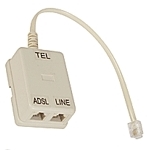 All things being equal, most, if not all, telcos would choose FTTH as their broadband access technology of choice. Its benefits are far reaching and there is the perception that to some extent, FTTH is future proof. But, in the real world, everything is not equal. DSL is still the king of broadband access, at least among telcos, due to the ubiquity of copper plant throughout the telecom network. Replacing that copper with fiber isn’t an inexpensive proposition.
All things being equal, most, if not all, telcos would choose FTTH as their broadband access technology of choice. Its benefits are far reaching and there is the perception that to some extent, FTTH is future proof. But, in the real world, everything is not equal. DSL is still the king of broadband access, at least among telcos, due to the ubiquity of copper plant throughout the telecom network. Replacing that copper with fiber isn’t an inexpensive proposition.
Alcatel-Lucent realizes this, and as the global leader of DSL port shipments, they have a vested interested in prolonging the life of DSL. Their Bell Labs unit recently demonstrated technology that boosts the theoretical transmission speeds of DSL to 300 Mbps, albeit at very short distance (400 meters or a little over 1,300 feet for the metric system challenged). At 1 kilometer (3,281 feet), the ‘DSL Phantom Mode’ technology delivered 100 Mbps. Makes you wonder what it will get at 10 kilofeet?
DSL Phantom Mode is a bonding technology that takes two DSL lines (two copper pairs) and creates a virtual or ‘phantom’ channel to supplement the physical limitations of the copper wires. In the Bell Labs test, they combine their phantom approach with an existing industry standard technique of ‘vectoring,’ which eliminates crosstalk interference between the two copper pairs. We reported about a similar approach from Ericsson a while back, who claimed they were achieving 500 Mbps for DSL.
Before you DSL ‘die hards’ start popping the champagne bottles, recognize these are experiments in a lab and are not ‘field tested.’ Alcatel-Lucent says, “Further research is being conducted to refine deployment models and determine a specific set of customer premises equipment (CPE)-models compatible with the DSL Phantom Mode technology.”
In other words, it will be a while before any commercial iteration of this technology appears, if ever. But it is encouraging to see continuing research and development into the current broadband workhorse for telcos across the world.

